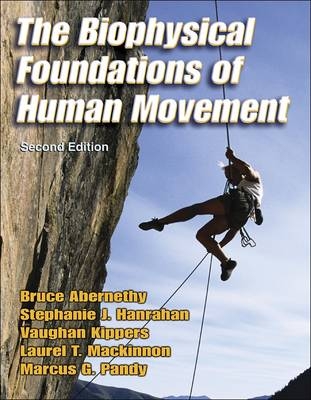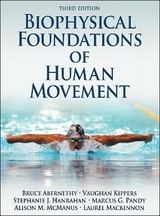
The Biophysical Foundations of Human Movement
Human Kinetics Publishers (Verlag)
978-0-7360-4276-5 (ISBN)
- Titel erscheint in neuer Auflage
- Artikel merken
This comprehensive book presents an integrated study of human movement and applies this knowledge to human performance and physical activity across the lifespan. The Biophysical Foundations of Human Movement, Second Edition, considers basic methods and concepts, typical research questions, key historical developments, professional training and organizations, and suggestions for further reading within each subdiscipline. The authors offer a unique perspective on the subdisciplines by exploring not only the basic science but also the changes in human movement and movement potential that occur throughout the lifespan as well in response to training, practice, and other lifestyle factors.
The second edition includes these new features:
-A completely rewritten and reorganized section on the mechanical bases of human movement
-A significantly expanded chapter on integrative perspectives with more examples of the interdisciplinary research at the forefront of the field
-Listings of the latest Web-based resources that focus on topics relevant to human movement studies
-Clear learning objectives and brief summaries in each chapter
The book provides students with an overview of the field and the many career options available to them. It highlights key organizations, prominent individuals, and studies from around the world that have contributed to our understanding of human movement. The book also contains numerous learning aids (including suggested readings, extensive illustrations, a detailed index, and a complete glossary) that improve comprehension and make review of the material easier.
Bruce Abernethy, PhD, is professor and director of the Institute of Human Performance at the University of Hong Kong. Previously, he was professor and head of the School of Human Movement Studies at the University of Queensland in Brisbane, Australia. He is coeditor of Creative Side of Experimentation. Dr. Abernethy earned his PhD from the University of Otago. He is an international fellow of the American Academy of Kinesiology and Physical Education, a fellow of Sports Medicine Australia, and a member of the Australian Association for Exercise and Sports Science. Stephanie J. Hanrahan, PhD, is an associate professor in sport and exercise psychology at the University of Queensland. She earned her doctorate in sport psychology from the University of Western Australia in 1989 and is a fellow of Sports Medicine Australia. Dr. Hanrahan is the 1997 recipient of the University of Queensland's Excellence in Teaching Award. She is the coauthor of The Coaching Process: A Practical Guide to Improving Your Effectiveness and Game Skills: A Fun Approach to Learning Sport Skills. Vaughan Kippers, PhD, is a senior lecturer in the School of Biomedical Sciences at the University of Queensland. Laurel T. Mackinnon, PhD, is an associate professor in the School of Human Movement Studies at the University of Queensland. In 1992, Dr. Mackinnon authored Advances in Exercise and Immunology, the first book to explore the intriguing relationship between exercise and the immune system. In 2003 she coauthored Exercise Management: Concepts and Professional Practice. She has received grant funding for projects related to overtraining and immune function in athletes. Marcus G. Pandy, PhD, is currently a professor of engineering in the Department of Biomedical Engineering at The University of Texas at Austin. He is also an associate editor of the Journal of Biomechanical Engineering, an executive member of the International Society of Biomechanics Computer Simulation Technical Group, and a member of the Scientific Advisory Committee of the Steadman-Hawkins Sports Medicine Foundation.
Chapter 1. Introduction-Human Movement Studies As a Discipline and a Profession-Human Movement Studies: Definition and Importance-Disciplines and Professions-Is Human Movement Studies a Discipline?-Structuring a Discipline of Human Movement Studies-Naming the Discipline of Human Movement Studies-Professions Based on Human Movement Studies-Relationships Between the Discipline and the Professions-Summary-Further Reading and References-Some Relevant Web SitesPart I: Anatomical Bases of Human Movement-The Subdiscipline of Functional Anatomy-Typical Questions Posed and Problems Addressed-Levels of Analysis-Historical Perspectives-Professional Training and Organizations-Further Reading and References-Some Relevant Web SitesChapter 2. Basic Concepts of the Musculoskeletal System-Tools for Measurement-The Skeletal System-Structure and Function of the Articular System-The Muscular System-Summary-Further Reading and ReferencesChapter 3. Basic Concepts of Anthropometry-Definition of Anthropometry-Tools for Measurement-Body Size-Determination of Body Shape-The Tissues Composing the Body-Somatotyping As a Description of Body Build-Human Variation-Summary-Further Reading and ReferencesChapter 4. Musculoskeletal Changes Throughout the Life Span-Definitions of Auxology and Gerontology-Tools for Measurement-Physical Growth, Maturation, and Aging-Age-Related Changes in the Skeletal and Articular Systems-Age-Related Changes in the Muscular System-Changes in Body Dimensions Throughout the Life Span-Methods of Determining Age-Summary-Further Reading and ReferencesChapter 5. Musculoskeletal Adaptations to Training-Effects of Physical Activity on Bone-Effects of Physical Activity on Joint Structure and Ranges of Motion-Effects of Activity Level on Muscle-Tendon Units-Effects of Physical Activity on Body Size, Shape, and Composition-Summary-Further Reading and ReferencesPart II: Mechanical Bases of Human Movement-The Subdiscipline of Biomechanics-Typical Questions Posed and Levels of Analysis-Historical Perspectives-Professional Organizations-Further Reading and References-Some Relevant Web SitesChapter 6. Basic Concepts of Kinematics and Kinetics-Vectors-Motion-Degrees of Freedom-Force-Moment of Force-Equilibrium-Computer Modelling of Movement-Summary-Further Reading and ReferencesChapter 7. Basic Concepts of Energetics-Energy and Power-Metabolic Energy Consumption-Efficiency of Movement-Summary-Further Reading and ReferencesChapter 8. Biomechanics Across the Life Span-Biomechanics of Normal Walking-Gait Development in Children-Gait Changes in Older Adults-Exercise and Aging-Summary-Further Reading and ReferencesChapter 9. Biomechanical Adaptations to Training-Muscular Adaptations to Training-Neuromuscular Adaptations to Training-Biomechanical Adaptations to Injury-Dependence of Motor Performance on Changes in Muscle Properties-Insights Into the Effects of Training Provided by Computer Models-Summary-Further Reading and ReferencesPart III: Physiological Bases of Human Movement-The Subdiscipline of Exercise Physiology-Applications of Exercise Physiology-Typical Questions Posed and Levels of Analysis-Historical Perspectives-Professional Organizations and Training-Further Reading and References-Some Relevant Web SitesChapter 10. Basic Concepts of Exercise Metabolism-Production of Energy for Exercise-Oxygen Supply During Sustained Exercise-Measurement of Exercise Capacity-The Cardiorespiratory System and Oxygen Supply During Exercise-Human Skeletal Muscle Cells-Energy Cost of Activity-Importance of Diet to Energy Metabolism and Exercise Performance-Summary-Further Reading and ReferencesChapter 11. Physiological Adaptations to Training-Training-Induced Metabolic Adaptations-Endurance Training-Induced Changes in the Cardiorespiratory System-Muscular System Changes After Strength Training-Basic Principles of Training-Training for Cardiovascular Endurance-Methods of Strength Training-Causes of Muscle Soreness-Exercise for Health-Related Fitness-Summary-Further Reading and ReferencesChapter 12. Physiological Capacity and Performance Across the Life Span-Responses to Exercise in Children-Adaptations to Exercise Training in Children-Exercise Capacity During Aging-Exercise Prescription for Older Adults-Life Span Sex Differences in Physiological Responses and Adaptations to Exercise-Summary-Further Reading and ReferencesChapter 13. Applications of Exercise Physiology to Health-Physical Activity and Public Health-Physical Activity, Cardiovascular Disease, and Metabolic Syndrome-Physical Activity and Other Leading Diseases and Conditions-Summary-Further Reading and ReferencesPart IV: Neural Bases of Human Movement-The Subdiscipline of Motor Control-Definition of Motor Control-Typical Questions Posed and Problems Addressed-Levels of Analysis Within Motor Control-Historical Perspectives-Professional Organizations and Training-Further Reading and References-Some Relevant Web SitesChapter 14. Basic Concepts of Motor Control: Neurophysiological Perspectives-Components of the Nervous System-Neurons and Synapses-Sensory Receptor Systems for Movement-Effector Systems for Movement-Motor Control Functions of the Spinal Cord-Motor Control Functions of the Brain-Integrative Brain Mechanisms for Movement-Summary-Further Reading and ReferencesChapter 15. Basic Concepts of Motor Control: Cognitive Science Perspectives-Using Models to Study Motor Control-Information-Processing Models of Motor Control-Some Alternative Models of Motor Control-Summary-Further Reading and ReferencesChapter 16. Motor Control Across the Life Span-Changes in Observable Motor Performance-Changes at the Neurophysiological Level-Changes in Information-Processing Capabilities-Summary-Further Reading and ReferencesChapter 17. Motor Control Adaptations to Training-Changes in Observable Motor Performance-Changes at the Neurophysiological Level-Changes in Information-Processing Capabilities-Factors Affecting the Learning of Motor Skills-Summary-Further Reading and ReferencesPart V: Psychological Bases of Human Movement-The Subdiscipline of Sport and Exercise Psychology-Typical Issues Posed and Problems Addressed-Levels of Analysis-Historical Perspectives-Professional Organizations-Further Reading and Reference-Some Relevant Web SitesChapter 18. Basic Concepts in Sport Psychology-Personality-Motivation in Sport-Arousal, Anxiety, and Sport Performance-The Practice of Applied Sport Psychology-Imagery: An Example of a Psychological Skill-Summary-Further Reading and ReferencesChapter 19. Basic Concepts in Exercise Psychology-Effects of Psychological Factors on Exercise-Effects of Exercise on Psychological Factors-Summary-Further Reading and ReferencesChapter 20. Physical Activity and Psychological Factors Across the Life Span-Changes in Personality-Psychosocial Development Through Sport Participation-Exercise in Older Adults-Termination of Athletic Careers-Summary-Further Reading and ReferencesChapter 21. Psychological Adaptations to Training-Aerobic Fitness and the Response to Psychological Stress-Changes in Personality-Changes in Motivation: Staleness, Overtraining, and Burnout-Changes in Mental Skills-Summary-Further Reading and ReferencesAfterword: Chapter 22. Multi- and Cross-Disciplinary Approaches to Human Movement-Specialization Versus Generalization-Examples of Multidisciplinary and Cross-Disciplinary Approaches-Summary-Further Reading and References
| Zusatzinfo | 215 black & white illustrations, 9 black & white halftones |
|---|---|
| Verlagsort | Champaign |
| Sprache | englisch |
| Maße | 216 x 279 mm |
| Themenwelt | Sachbuch/Ratgeber ► Sport |
| Studium ► 1. Studienabschnitt (Vorklinik) ► Physiologie | |
| ISBN-10 | 0-7360-4276-8 / 0736042768 |
| ISBN-13 | 978-0-7360-4276-5 / 9780736042765 |
| Zustand | Neuware |
| Haben Sie eine Frage zum Produkt? |
aus dem Bereich



